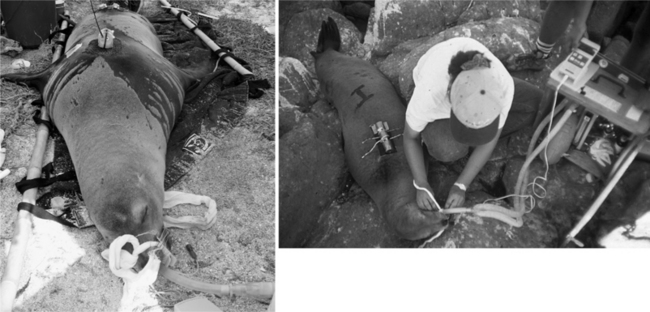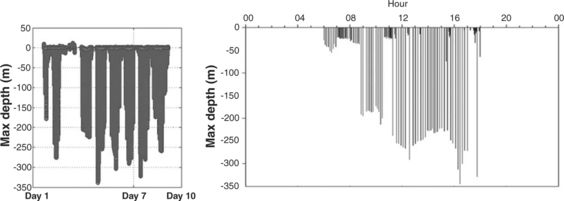Chapter 39 Capture and Anesthesia of Otariids in the Wild
Otariids are widely distributed in coastal regions throughout the world. The family Otariidae, in the order Pinnipedia, includes sea lions and fur seals (14 species in seven genera). As a group, they are distinguished from the true seals by their use of the fore flippers as the principal means of propulsion. Sea lions, which have broader muzzles and lack underfur, are generally larger than most fur seals. All species of otariids are gregarious and sexually dimorphic; males are substantially larger and darker in color than females.
Some of the populations of these species are relatively small, such as the Galápagos fur seal (Arctocephalus galapagoensis), the Galápagos sea lion (Zalophus wollebaeki), the isolated California sea lion (Zalophus californianus) population found in the Sea of Cortez in Mexico (20,000-30,000 individuals), and the Guadalupe fur seal (Arctocephalus townsendi), with no more than 8000 individuals. These populations have experienced significant reduction in size attributed to bacterial and viral epizootic diseases, contamination, the introduction of exotic species, competition with humans, and decreased food resources resulting from climatic phenomena such as El Ni-o Southern Oscillation events, which have caused up to 99% mortality in pups.15
Otariids are high-metabolism predators that consume species that aggregate in dense schools (sardines, anchovies, mackerel, hake) and normally are associated with upwelling zones where abundant food maintains populations as great as millions of individuals.1 In several monitoring programs of marine ecosystem health, the study of otariids as sentinel species has intensified in the past few decades, including research on population dynamics, ecology, and interactions of these animals with the fisheries. The direct handling of otariids has been carried out since the 1980s using physical restraint and more recently with anesthesia, to mark, weigh, and measure animals and collect biologic samples. The study of adult females reflects local environmental conditions because they remain for most of the year near the reproductive areas. With increased longevity, the raising of offspring may extend up to 1 year or more, and thus a good body condition of the female reflects in general a good health condition of the pups. The health study of pups offers a practical alternative to indirect evaluation of the condition of the mothers and the general condition of the colony.11
Field studies that require the close manipulation of otariid females and pups call for effective techniques that have only a minor impact on the individuals and the breeding rookeries. The capture and anesthesia of individuals in field conditions differ in some ways from methods with captive animals; the history of the animal is unknown, their weight and physiologic status must be estimated, a fast recovery is required, and often the work is done under adverse climatic conditions. Normally the goals of the studies are to obtain accurate morphometric measurements and biologic samples, to measure physiologic data, and to attach biotelemetry equipment Figure 39-1.
This chapter addresses the capture and anesthesia of free-ranging otariids.
UNIQUE ANATOMY AND PHYSIOLOGY
Otariids have specialized adaptations related to the amazing diving they perform Figure 39-2, such as highly efficient lungs for gas exchange, higher blood volume with an increased capacity to transport oxygen, and muscles rich in myoglobin. When submerged, otariids exhibit a dive response that involves the following2:
Cardiovascular adaptations in the venous system, such as the large hepatic sinus formed from the hepatic veins, works as a large-capacity blood reservoir, which is presumed to assist in the shunting of circulating blood only to vital organs during a dive.4
Other anatomic particularities are the long tongue, which is poorly mobile; reduced mandibular mobility; prominent arytenoid cartilages; a small, flexible epiglottis; and the trachea, which bifurcates in the region of the thoracic inlet.12
CAPTURE AND HANDLING
Physical restraint of these animals in the field presents many challenges because of the long hydrodynamic body, the size and strength of the adults, the need to control the head and the pectoral flippers, and the high incidence of hyperthermia during capture. The environment in which otariids live also presents challenges; for example, in some areas, such as desert climate and islands with difficult access to rocky beaches, the research protocol may require the capture of a specific individual from hundreds of animals over rough terrains or the transport of an individual by land or sea to the research camp.
Stay updated, free articles. Join our Telegram channel

Full access? Get Clinical Tree




